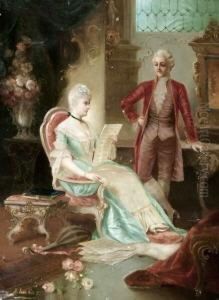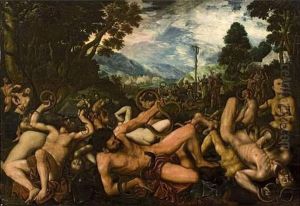Lukas De Heere Paintings
Lukas De Heere was a Flemish painter, poet, and writer who was born in Ghent, then part of the Spanish Netherlands, in 1534. His father was a painter and a tapestry designer, which allowed De Heere to be exposed to the world of art from an early age. He was trained by his father and later became a pupil of Frans Floris, one of the leading Flemish Renaissance painters of the time. De Heere was known for his portraits and historical paintings, as well as his work in designing tapestries.
De Heere's career took a significant turn when he was forced to flee to England in 1567 due to the political and religious turmoil in the Low Countries caused by the Dutch Revolt against Spanish rule. In England, De Heere found a receptive audience for his talents and became associated with the Protestant court of Queen Elizabeth I. He painted numerous portraits of English nobility and contributed to the decoration of royal palaces. His work in England reflects the Elizabethan taste for elaborate and symbolic portraits.
In addition to his painting, De Heere was also an accomplished writer and poet. He penned a Dutch-language treatise on painting that provided insights into the techniques and practices of the time. His writings are valuable to art historians for their detailed descriptions of Northern Renaissance art practices.
Lukas De Heere's influence extended beyond his immediate work; he was part of the larger movement of Northern Renaissance artists who were instrumental in spreading Renaissance styles and ideas throughout Northern Europe. Unfortunately, there is limited information about his later life, and many of his works have been lost or remain unidentified. De Heere died in 1584, and while he is not as widely remembered as some of his contemporaries, his contributions to Renaissance art and his role in the cultural exchanges between the Low Countries and England during a turbulent period in European history are significant.

